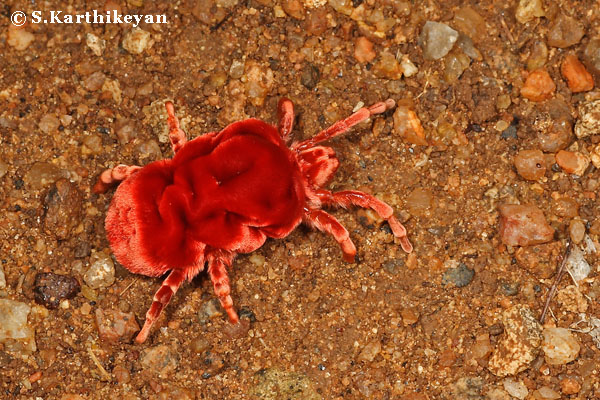I was walking down the forest track. A little distance from where I was, was a little red creature lumbering down towards me. When I was just a few feet from it I knew what it was. And, this one was indeed a particularly large Red Velvet Mite.
To show it to those with me, I gently picked it up. True to its name it felt like velvet. No sooner than I picked it up, than it withdrew its appendages and lay motionless. This helped me draw attention to its body parts and legs. Being an arachnid (related to spiders, scorpions and ticks), its body was divided only into 2 parts and had 4 pairs of legs (as against 3 body parts and 3 pairs of legs for insects). When I put the velvet ball down, it happily walked away as if nothing had transpired. During the rest of the morning trail, we encountered several more of the Red Velvet Mites of various sizes – most of them smaller than half a centimetre while the odd ones, like the one that I picked up, were about a centimetre in length. These bright red mites walked about without any fear. Probably, owing to their bright red colour that offers them protection from possible predators.
The forest floor was drenched in the first few showers of the southwest monsoon that had graced the forest over the last few days. There was also ample leaf litter around. The conditions were ideal for the emergence of this pretty arachnid – this explained the abundance of these mites. After this brief emergence, they again disappear only to emerge during the early days of monsoon the following year. They are known to live, at times, for more than a year. As adults, they are part of a community of soil arthropods, and are thought to perform a very important role in the ecosystem. As larvae these mites are ectoparasites and are known to parasitize insects like grasshoppers and other arthropods. Many of these mites are dependent on invertebrates that live in the soil for food and consequently spending more time underground. They emerge when the soil is drenched.
The Red Velvet Mites have a wide distribution. There are reports of it even within Bangalore (L.Shyamal). I have seen them on the outskirts of Bangalore as well as in the vicinity of the Cauvery Fishing Camp, Bheemeshwari and even a much farther location like the Sloth Bear Resort in Hampi. They occur in the dry scrub jungles, deciduous forests and also wetter areas. So, look out for these little creatures if you are in the outdoors this time of the year.
